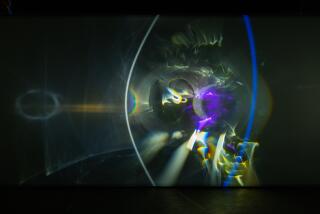Review: The sculptures that help you to see (and feel) color in a new light
- Share via
The magical mysteries of color strut their shape-shifting stuff in “Peter Alexander, Sculpture 1966-2016: A Career Survey” at Parrasch Heijnen Gallery in Boyle Heights, where the exhibition is a garden of earthly delights. Its 21 pieces meld simple shapes and complex colors to give beauty a real kick.
Many of the colors that spill from Alexander’s sharply focused sculptures are not what anyone would call natural: matte chartreuse, frosted crème de menthe, rosy-eyeglasses pink and flashing emergency-light red. Alexander’s palette conjures a world of hi-tech synthetics and sci-fi futurism. Such fabricated realities usually leave little room for humans.
But other sculptures recall nature at its most dazzling: the night sky seen from beneath the surface of an illuminated swimming pool, icicles reflecting sunshine on a sub-zero afternoon and waves gently lapping a sandy beach — just before disappearing into the wet sand.
The combination of outlandish artifice and grounded experience is startling. And it’s just the beginning.
To walk around such sculptures as “Pink Block,” “Small Cloud Box” and “Pyramid” is to see space expand and contract, both within Alexander’s semi-translucent sculptures and outside of them, right where you’re standing.
To catch a glimpse of one sculpture in the surface of another is pretty trippy. If mirrors and windows had 3-D offspring, they might be the ill-bred second cousins of Alexander’s fantastic sculptures.
Nothing if not seductive, they make ample room for viewers. Their forms recall tools (wedges and ramps), supplies (bricks and beams) and architecture (buildings and windows). The optics of sculpture never looked better.
Chronologically, Alexander’s slices, chunks, bumps, wedges, beams and slabs of color fall into two short spans of time: Eleven date from 1966 to 1971, and 10 from 2013 to 2016. The first are made of polyester resin, which Alexander quit using in 1972 because it was a health hazard.
For the next 35 years he made paintings on velvet, canvas and linen, always looking for ways to make light tangible. In 2007, he was commissioned to reconstruct one of his polyester resin sculptures that had been damaged in a Paris museum. He discovered that he could use urethane, which was safer.
Since then, that has become his go-to material. It does lots of the things his early works do as well as some others. Works like “9/17/15 Big Red Puff,” “9/16/14 (Flo Yellow Tablet)” and “4/13/16 (Clear Leaner)” come from another part of the spectrum and bring different sensations with them. Some seem more liquid. Others more opaque. Still others more brittle, even crispy.
The energy generated between Alexander’s early works and new ones is urbane and uncanny, exceptionally sophisticated yet refreshingly unpretentious. Too civilized to make your head spin, Alexander’s sculptures still make your heart race. The imagination leaps.
------------
Parrasch Heijnen Gallery, 1326 S. Boyle Ave., Los Angeles. Through Sept. 2. Closed Sundays and Mondays. (323) 943-9373, www.parrasch-heijnen.com
Follow The Times’ arts team @culturemonster.
More to Read
The biggest entertainment stories
Get our big stories about Hollywood, film, television, music, arts, culture and more right in your inbox as soon as they publish.
You may occasionally receive promotional content from the Los Angeles Times.










